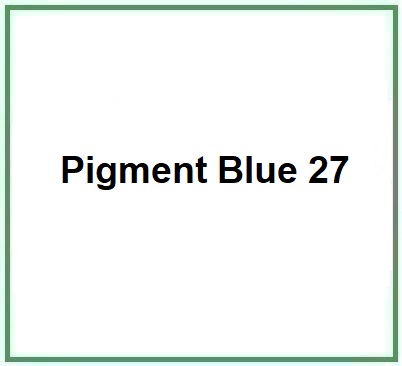Pigment Blue 27 is a chemical compound known as ferric ammonium ferrocyanide, is chemically classified as an inorganic colorant. This pigment is widely used in various industrial and cosmetic applications due to its distinctive blue color and excellent stability.
Chemical name
- Ferric Ammonium Ferrocyanide
The name describes the structure of the molecule:
- Ferric refers to trivalent iron (Fe³⁺). "Ferric" comes from the Latin "ferrum," meaning iron.
- Ammonium is derived from ammonia (NH₃). In this context, it indicates the presence of ammonium ions (NH₄⁺) in the compound.
- Ferrocyanide is derived from iron and cyanide. It indicates the presence of the ferrocyanide complex ([Fe(CN)₆]⁴⁻), which is an anion containing iron and cyanide.
Chemical Composition and Structure
Pigment Blue 27 is an inorganic compound with the chemical formula (NH4)Fe[Fe(CN)6]. It consists of ferric ammonium ferrocyanide, a complex compound containing iron, ammonium, and ferrocyanide ions. This composition gives the pigment its characteristic blue color.
Physical Properties
This pigment typically appears as a fine blue powder. It has high density and excellent covering power. Pigment Blue 27 is known for its chemical stability, resistance to light and heat, and inert nature, making it suitable for long-lasting applications. Its opacity and strong tinting strength make it a versatile pigment for various uses.
Chemical Industrial Synthesis Process
- Preparation of reagents. The main raw materials include potassium ferrocyanide (K₄[Fe(CN)₆]), ferric sulfate (Fe₂(SO₄)₃), and ammonium sulfate ((NH₄)₂SO₄).
- Preparation of ferrocyanide solution. The potassium ferrocyanide is dissolved in deionized water to form a ferrocyanide solution.
- Addition of ferric sulfate. Ferric sulfate is slowly added to the ferrocyanide solution with constant stirring. This reaction forms a precipitate of ferric ferrocyanide (Fe₄[Fe(CN)₆]₃).
- Addition of ammonium sulfate. Ammonium sulfate is added to the resulting suspension, which reacts with the ferric ferrocyanide to form ferric ammonium ferrocyanide.
- Filtration. The suspension is filtered to separate the solid precipitate from the aqueous solution.
- Washing. The precipitate is washed with deionized water to remove any soluble impurities.
- Drying. The washed precipitate is dried at controlled temperatures to remove residual moisture and obtain a dry powder.
- Grinding. The dried precipitate is ground to obtain a fine and uniform powder. This step may involve the use of ball mills or other grinding machinery.
- Classification. The dried powder is classified to ensure a uniform particle size. This step may involve sieving or the use of air classifiers.
- Stabilization. The Pigment Blue 27 powder is stabilized to ensure its stability during transportation and storage, preventing aggregation and degradation.
- Quality control. The Pigment Blue 27 undergoes rigorous quality testing to ensure it meets standards for purity, color intensity, and safety. These tests include chemical analysis, spectroscopy, and physical tests to determine particle size and rheological properties.
What it is used for and where
Cosmetics
Restricted cosmetic ingredient as IV/138 a Relevant Item in the Annexes of the European Cosmetics Regulation 1223/2009. Substance or ingredient reported:
- Ferric Ammonium Ferrocyanide. Wording of conditions of use and warnings: free from cyanide ions
Cosmetics - INCI Functions
Colorant. This ingredient has the function of colouring the solution in which it is inserted in a temporary, semi-permanent or permanent manner, either alone or in the presence of the complementary components added for colouring.
Pigment Blue 27 is used in cosmetic products such as eyeshadows, mascaras, and eyeliners due to its intense blue color and high opacity. It provides long-lasting color.

Industrial Applications
Paints and Coatings: In the paint industry, ferric ammonium ferrocyanide is used to achieve deep blue shades and enhance UV resistance. Its stability and strong tinting properties make it ideal for both decorative and protective coatings.
Plastics and Polymers: This pigment is employed in the production of plastics and polymers to improve color uniformity and opacity. It is commonly used in products like automotive parts, packaging materials, and consumer goods.
Ceramics and Glass: Pigment Blue 27 is used in the production of ceramics and glass to achieve stable blue colors. It is particularly valued for its resistance to high-temperature processes.
Inks: The pigment is also used in printing inks to produce intense blue colors, ensuring high-quality and durable prints.
Animal feed. This ingredient is used as a technological additive for feed for domestic and wild ruminants. Maximum recommended and safe concentration: 500 mg/kg feed (approximately 150 mg ferric ammonium hexacyanoferrate (III)/10 kg body weight) (1).
Safety
Pigment Blue 27 is generally considered safe for use in consumer products when handled according to proper safety procedures. It is important to avoid inhalation of the powder and minimize direct contact with skin and eyes.
- Molecular Formula C6H4Fe2N7
- Molecular Weight 285.83 g/mol
- CAS 25869-00-5
- UNII 9R0NVI936I
- EC Number 237-875-5
- DTXSID1029332
Synonyms:
Pigment Blue 27
Ferric Ammonium Ferrocyanide
CI 77510
References___________________________________________________________________________
(1) EFSA Panel on Additives and Products or Substances used in Animal Feed (FEEDAP); Bampidis V, Azimonti G, Bastos ML, Christensen H, Dusemund B, Fašmon Durjava M, Kouba M, López-Alonso M, López Puente S, Marcon F, Mayo B, Pechová A, Petkova M, Ramos F, Sanz Y, Villa RE, Woutersen R, Innocenti ML, Pizzo F, Galobat J, Holczknecht O, Bories G, Gropp J, Nebbia C, Aquilina G. Safety and efficacy of a feed additive consisting of ferric (III) ammonium hexacyanoferrate (II) for ruminants (domestic and wild), calves prior the start of rumination, lambs prior the start of rumination, kids prior the start of rumination and pigs (domestic and wild) (Honeywell Specialty Chemicals Seelze GmbH). EFSA J. 2021 Jun 11;19(6):e06628. doi: 10.2903/j.efsa.2021.6628. PMID: 34136002; PMCID: PMC8193505.
Abstract. Following a request from the European Commission, EFSA was asked to deliver a scientific opinion on the safety and efficacy of ferric (III) ammonium hexacyanoferrate (II) as technological feed additive for ruminants (domestic and wild), calves prior the start of rumination, lambs prior the start of rumination, kids prior the start of rumination and pigs (domestic and wild). The additive is already authorised for use in ruminants (domestic and wild), calves prior the start of rumination, lambs prior the start of rumination, kids prior the start of rumination and pigs (domestic and wild). The additive is effective at the minimum recommended concentration of 50 mg/kg complete feedingstuffs (corresponding to about 10 mg/10 kg bw) in reducing the contamination of food derived from ruminants (domestic and wild), calves, lambs and kids prior to the start of rumination, and pigs (domestic and wild) by caesium. Considering the scarce information available, the Panel is not in the position to conclude on the safety of the additive for the target species. The use of ferric (III) ammonium hexacyanoferrate (II) in feed for ruminants, calves, lambs, kids and pigs at the maximum recommended concentration of 500 mg/kg feed (corresponding to about 150 mg ferric (III) ammonium hexacyanoferrate (II)/10 kg bw) is safe for the consumer. In the absence of data, the Panel is not in the position to conclude on the safety of the additive for the user. The use of ferric (III) ammonium hexacyanoferrate (II) as a feed additive is considered safe for the environment. © 2021 European Food Safety Authority. EFSA Journal published by John Wiley and Sons Ltd on behalf of European Food Safety Authority.
![]() Pigment Blue 27
Pigment Blue 27 


